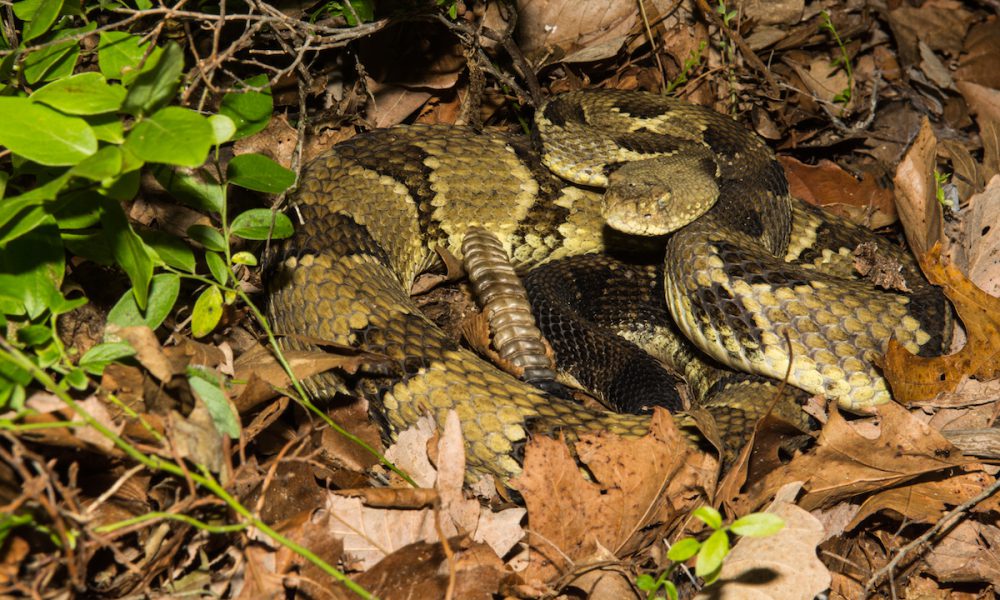
The Timber rattlesnake (Latin name of Crotalus horridus) is also commonly known as canebrake rattlesnake or banded rattlesnake, is a species of venomous pip viper found in the eastern region of the United States.
Habitat
Timber rattlesnakes are found in lowland cane thickets, deciduous forests in rugged terrain, high areas around swamps and river floodplains, mountainous areas, pine and hardwood forests and also in rural habitats in farming areas. Their numbers are typically lower in the highly urbanized or housing development areas.
Appearance
The timber rattlesnake has a wide head and narrow neck and is a large, heavy-bodied snake with the characteristic rattle on the end of the tail.
Adult snakes range from 30 to 60 inches in length, with the record specimen being more than 6 feet long. They weigh on average between 1.1 and 3.3 lbs. but large snakes can weigh as much as 9.9 lbs.
In terms of the pattern that is showed on the body of the snake, it is usually an irregular striped pattern, with narrow dark bands alternating with lighter green-brown bands. Although the majority of these snakes do have a striped pattern of green or brown scales, there are many of these snakes that actually are much darker, and in some cases can be entirely black.
Dangerous
Potentially, this is one of North America’s most dangerous snakes, due to its long fangs, impressive size, and high venom yield, but the numbers of attacks on people are relatively few and far between. The species became an important symbol during the American Revolution, and in 2008 the state of West Virginia adopted the Timber Rattlesnake as its official state reptile. In the southern states, it’s often called the Canebrake Rattlesnake.
Venom / Bite
The timber rattlesnake is the 3rd largest venomous snake in the US and is one of North America’s most dangerous snakes, due to its impressive size, long fangs and high venom yield. However, the species relatively mild disposition and a long hibernation period mean there aren’t that many bites.
The bite symptoms include local pain and swelling, nausea, vomiting, stomach cramping and diarrhea, and muscular spasms throughout the entire body.
Diet
The Canebrake rattlesnake will usually hunt at night and is able to consume a wide range of different small animals depending on what it can find. Timber rattlesnakes eat mainly small mammals, but their diet may also include small birds, frogs, mice, other small animals or even other snakes. These rattlesnakes are predators waiting for prey to pass nearby before striking.
One of the interesting aspects of the snake is that because it hunts at night it has an excellent ability to sense vibration, and even before it strikes at its prey it will know roughly the size of the approaching animal. The Timber Rattlesnake will strike its prey and inject the venom and will then follow for the short period of time before it dies before swallowing the victim whole.
If you see any signs of snakes, call a professional pest control company sooner than later to handle it for you especially if it is a venomous one! To learn more, read our blog 6 Venomous Snakes in Georgia.
Houseman is the only complete service company in the Athens, GA area. We provide Weed control, fertilization, shrub care, mulch & pine straw, sod, annual plantings, irrigation, and commercial & residential lawn maintenance. We are also state certified and licensed in wood destroying organisms (termite control), household pest control, public heath, and turf & ornamental weed control. We are licensed to control and treat mosquitoes, termites, all pest problems and turf & ornamental weed control. Contact the professionals at Houseman Services and set up a free inspection of your yard. We have been servicing homes and businesses in the Athens, Clarke County area since 1985!